Case Study Analysis: Nursing Care for Tonic-Clonic Seizure Patients
VerifiedAdded on 2022/10/02
|12
|3172
|6
Case Study
AI Summary
This case study examines an 18-year-old patient, Georgia Sands, who experienced a tonic-clonic seizure, requiring emergency department intervention. The assignment delves into the pathophysiology of tonic-clonic seizures, explaining the abnormal electrical activity in the brain and its effects. It explores potential causes, including emotional stress, hormonal influences, diet, and environmental factors like flashing lights. The clinical manifestations, such as loss of consciousness, muscle stiffening, and post-ictal state symptoms, are detailed. Furthermore, the case study provides a comprehensive overview of nursing care and assessment, covering actions during the seizure, immediate post-seizure care, and ongoing monitoring, including the importance of patient safety, observation, and providing support and reassurance. The assignment emphasizes the need for accurate documentation and the administration of appropriate medications to manage pain and potential complications.
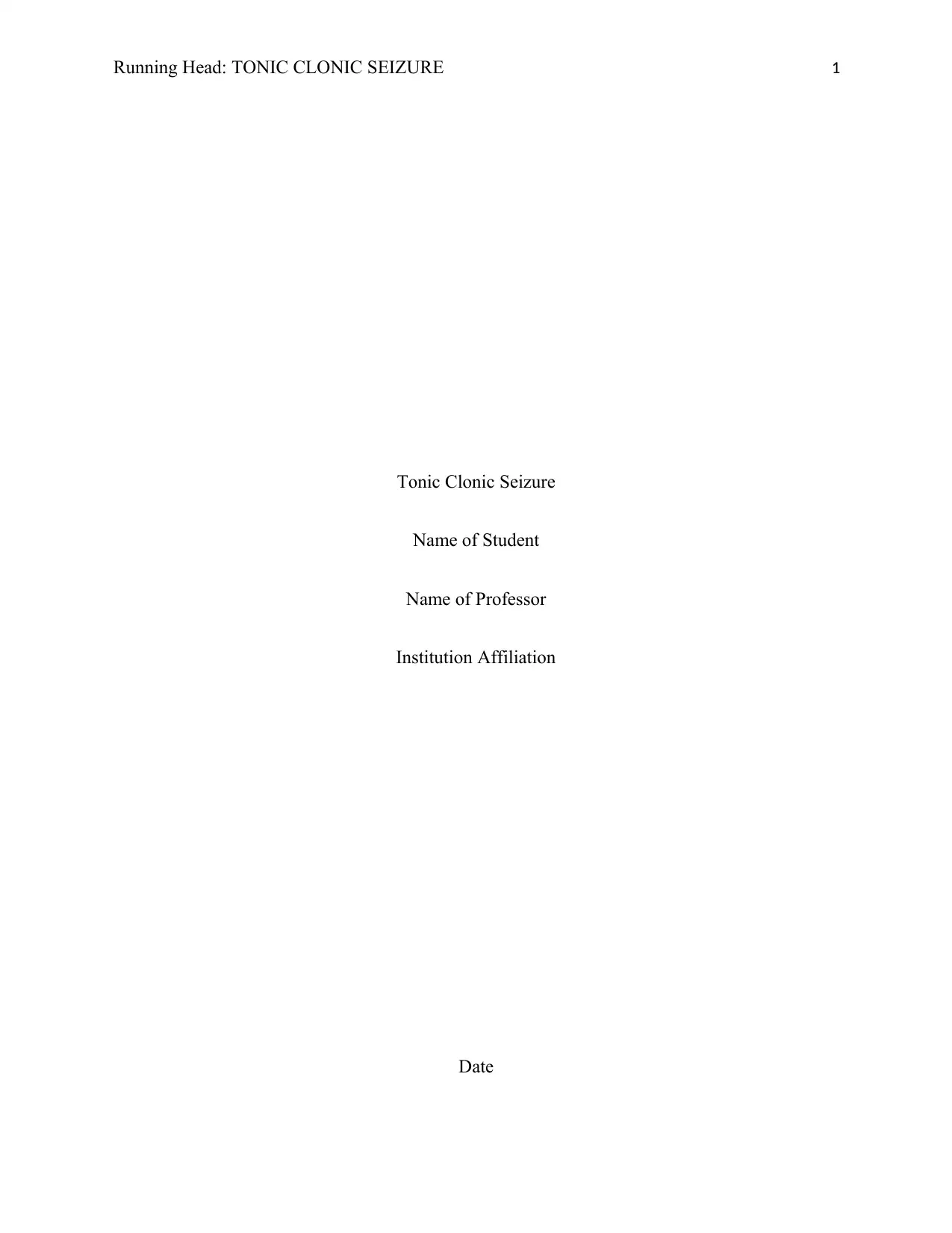
Running Head: TONIC CLONIC SEIZURE 1
Tonic Clonic Seizure
Name of Student
Name of Professor
Institution Affiliation
Date
Tonic Clonic Seizure
Name of Student
Name of Professor
Institution Affiliation
Date
Secure Best Marks with AI Grader
Need help grading? Try our AI Grader for instant feedback on your assignments.
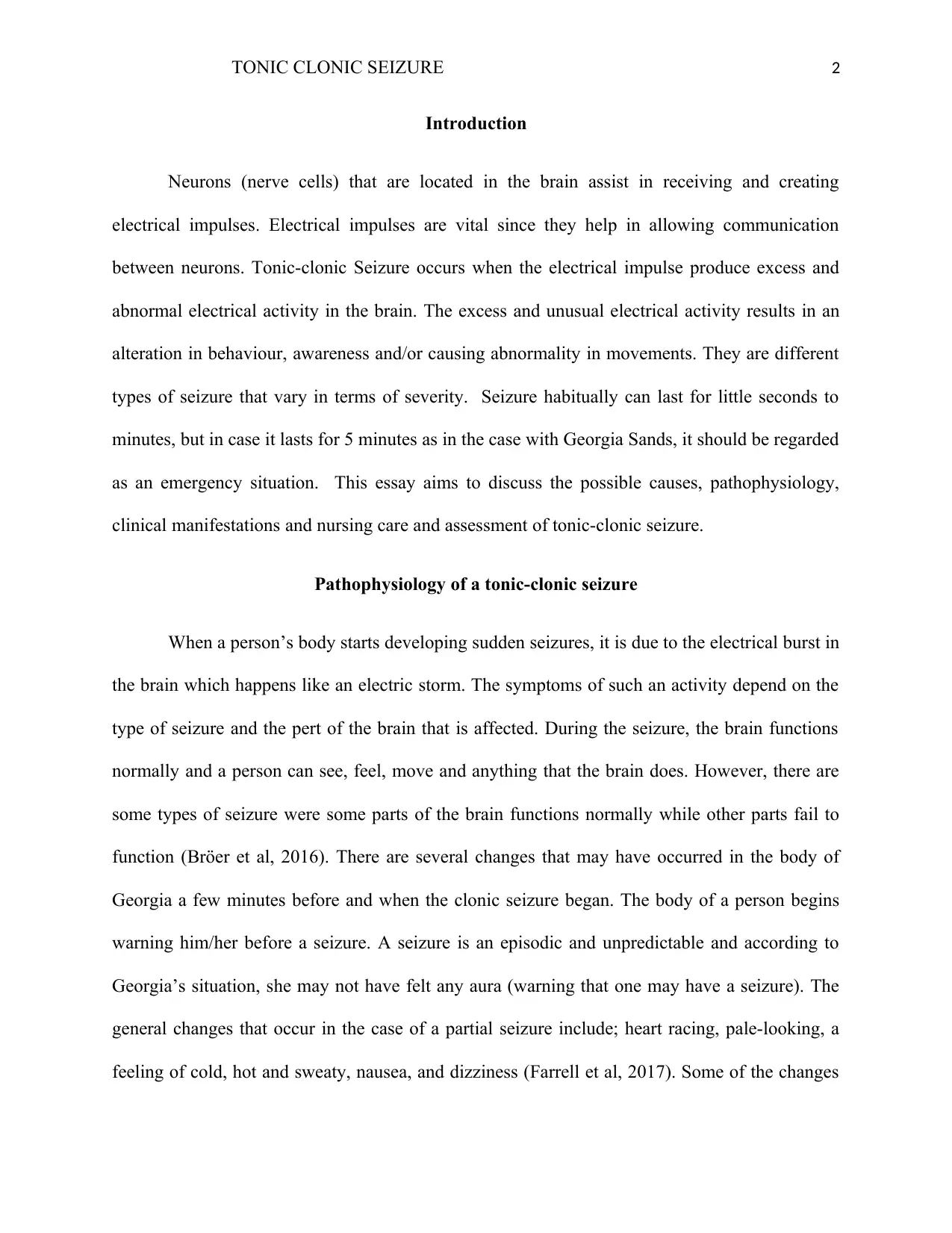
TONIC CLONIC SEIZURE 2
Introduction
Neurons (nerve cells) that are located in the brain assist in receiving and creating
electrical impulses. Electrical impulses are vital since they help in allowing communication
between neurons. Tonic-clonic Seizure occurs when the electrical impulse produce excess and
abnormal electrical activity in the brain. The excess and unusual electrical activity results in an
alteration in behaviour, awareness and/or causing abnormality in movements. They are different
types of seizure that vary in terms of severity. Seizure habitually can last for little seconds to
minutes, but in case it lasts for 5 minutes as in the case with Georgia Sands, it should be regarded
as an emergency situation. This essay aims to discuss the possible causes, pathophysiology,
clinical manifestations and nursing care and assessment of tonic-clonic seizure.
Pathophysiology of a tonic-clonic seizure
When a person’s body starts developing sudden seizures, it is due to the electrical burst in
the brain which happens like an electric storm. The symptoms of such an activity depend on the
type of seizure and the pert of the brain that is affected. During the seizure, the brain functions
normally and a person can see, feel, move and anything that the brain does. However, there are
some types of seizure were some parts of the brain functions normally while other parts fail to
function (Bröer et al, 2016). There are several changes that may have occurred in the body of
Georgia a few minutes before and when the clonic seizure began. The body of a person begins
warning him/her before a seizure. A seizure is an episodic and unpredictable and according to
Georgia’s situation, she may not have felt any aura (warning that one may have a seizure). The
general changes that occur in the case of a partial seizure include; heart racing, pale-looking, a
feeling of cold, hot and sweaty, nausea, and dizziness (Farrell et al, 2017). Some of the changes
Introduction
Neurons (nerve cells) that are located in the brain assist in receiving and creating
electrical impulses. Electrical impulses are vital since they help in allowing communication
between neurons. Tonic-clonic Seizure occurs when the electrical impulse produce excess and
abnormal electrical activity in the brain. The excess and unusual electrical activity results in an
alteration in behaviour, awareness and/or causing abnormality in movements. They are different
types of seizure that vary in terms of severity. Seizure habitually can last for little seconds to
minutes, but in case it lasts for 5 minutes as in the case with Georgia Sands, it should be regarded
as an emergency situation. This essay aims to discuss the possible causes, pathophysiology,
clinical manifestations and nursing care and assessment of tonic-clonic seizure.
Pathophysiology of a tonic-clonic seizure
When a person’s body starts developing sudden seizures, it is due to the electrical burst in
the brain which happens like an electric storm. The symptoms of such an activity depend on the
type of seizure and the pert of the brain that is affected. During the seizure, the brain functions
normally and a person can see, feel, move and anything that the brain does. However, there are
some types of seizure were some parts of the brain functions normally while other parts fail to
function (Bröer et al, 2016). There are several changes that may have occurred in the body of
Georgia a few minutes before and when the clonic seizure began. The body of a person begins
warning him/her before a seizure. A seizure is an episodic and unpredictable and according to
Georgia’s situation, she may not have felt any aura (warning that one may have a seizure). The
general changes that occur in the case of a partial seizure include; heart racing, pale-looking, a
feeling of cold, hot and sweaty, nausea, and dizziness (Farrell et al, 2017). Some of the changes

TONIC CLONIC SEIZURE 3
that happened in the Georgia’s body as his case was sudden which is recommended as a tonic-
clonic seizure include; abnormal breathing, unable to swallow, biting of his tongue because the
muscles tighten making one's teeth to clench, drooling, and one also is unable to control her
bladder (Stafstrom, & Carmant, 2015).
Causes of tonic clonic seizures
The beginning of TCS could have been triggered by several health conditions. Several
factors are known for increasing the onset of TCS, for instance, the usage of alcohol, previous
occurrence of a seizure or a family history of TCS. In the case scenario according to the
assessment conducted to Georgia it is clear she does not have a family history of TCS, no
history of seizure, she is a non-smoker and is also not involved in the usage of alcohol hence
those cannot be the probable causes of the seizure. It is also clear from the case scenario that
Georgia has no significant medical illness or history that could have resulted in her experiencing
the seizure. Therefore the condition of Georgia could be a non-epileptic seizure. It is hard to
determine the exact causes of the seizure that Georgia is experiencing since it is the first time
(Regola, Tincani & Toniati, 2019). Therefore some factors that could have triggered the
occurrence of seizure in the case scenario include;
Emotional upset, excitement and stress. They increase the chances of seizure occurrence since
they can result in poor eating and sleeping habits. Poor sleeping and eating habits decrease the
chances of a person resisting the event of TCS. The inadequate sleep results to changes in the
normal functioning of the brain, which influence the electrical activity and hence triggering the
occurrence of TCS (Eyre, Corrales, Silvestri, Miller & Bhatia, 2017).
that happened in the Georgia’s body as his case was sudden which is recommended as a tonic-
clonic seizure include; abnormal breathing, unable to swallow, biting of his tongue because the
muscles tighten making one's teeth to clench, drooling, and one also is unable to control her
bladder (Stafstrom, & Carmant, 2015).
Causes of tonic clonic seizures
The beginning of TCS could have been triggered by several health conditions. Several
factors are known for increasing the onset of TCS, for instance, the usage of alcohol, previous
occurrence of a seizure or a family history of TCS. In the case scenario according to the
assessment conducted to Georgia it is clear she does not have a family history of TCS, no
history of seizure, she is a non-smoker and is also not involved in the usage of alcohol hence
those cannot be the probable causes of the seizure. It is also clear from the case scenario that
Georgia has no significant medical illness or history that could have resulted in her experiencing
the seizure. Therefore the condition of Georgia could be a non-epileptic seizure. It is hard to
determine the exact causes of the seizure that Georgia is experiencing since it is the first time
(Regola, Tincani & Toniati, 2019). Therefore some factors that could have triggered the
occurrence of seizure in the case scenario include;
Emotional upset, excitement and stress. They increase the chances of seizure occurrence since
they can result in poor eating and sleeping habits. Poor sleeping and eating habits decrease the
chances of a person resisting the event of TCS. The inadequate sleep results to changes in the
normal functioning of the brain, which influence the electrical activity and hence triggering the
occurrence of TCS (Eyre, Corrales, Silvestri, Miller & Bhatia, 2017).
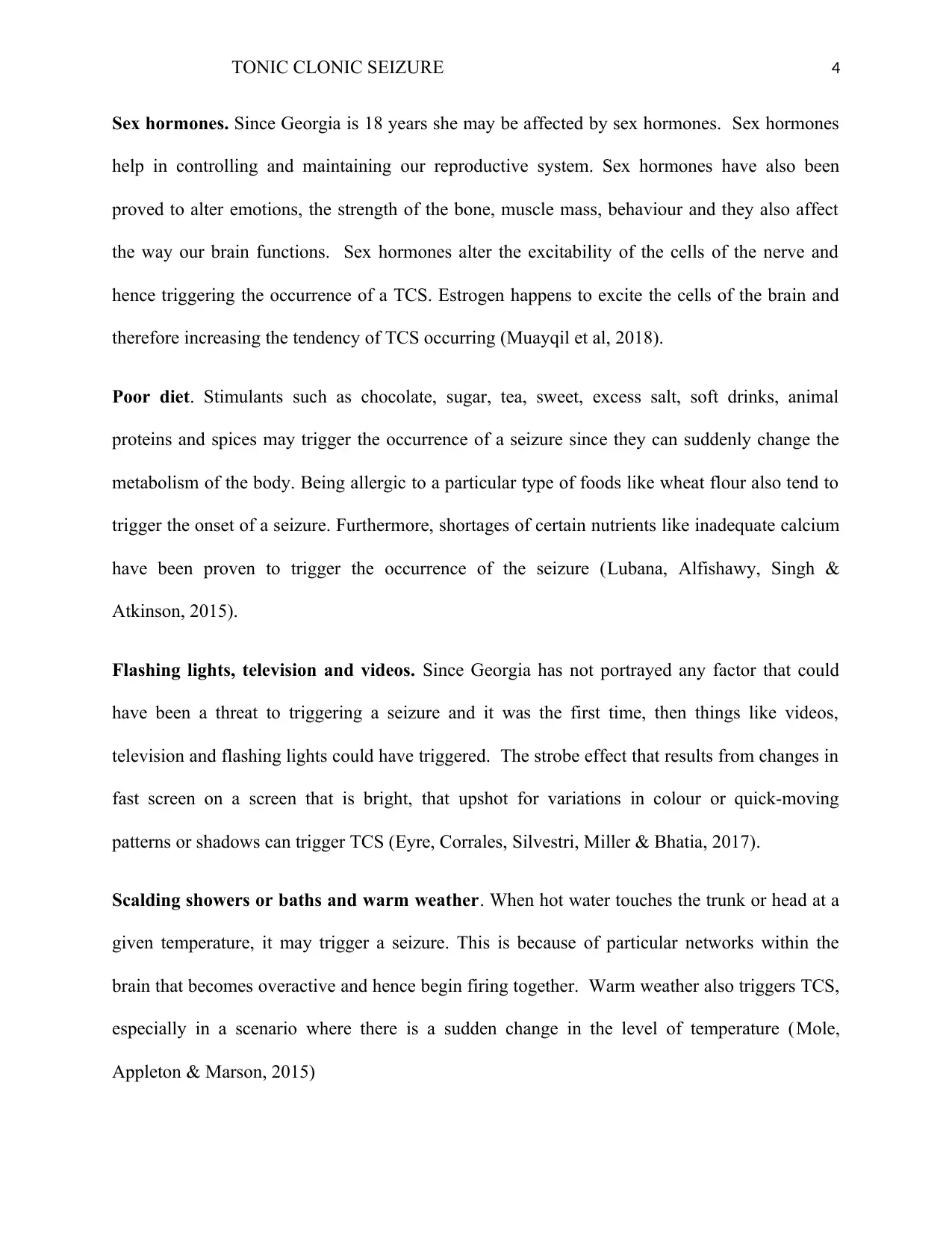
TONIC CLONIC SEIZURE 4
Sex hormones. Since Georgia is 18 years she may be affected by sex hormones. Sex hormones
help in controlling and maintaining our reproductive system. Sex hormones have also been
proved to alter emotions, the strength of the bone, muscle mass, behaviour and they also affect
the way our brain functions. Sex hormones alter the excitability of the cells of the nerve and
hence triggering the occurrence of a TCS. Estrogen happens to excite the cells of the brain and
therefore increasing the tendency of TCS occurring (Muayqil et al, 2018).
Poor diet. Stimulants such as chocolate, sugar, tea, sweet, excess salt, soft drinks, animal
proteins and spices may trigger the occurrence of a seizure since they can suddenly change the
metabolism of the body. Being allergic to a particular type of foods like wheat flour also tend to
trigger the onset of a seizure. Furthermore, shortages of certain nutrients like inadequate calcium
have been proven to trigger the occurrence of the seizure (Lubana, Alfishawy, Singh &
Atkinson, 2015).
Flashing lights, television and videos. Since Georgia has not portrayed any factor that could
have been a threat to triggering a seizure and it was the first time, then things like videos,
television and flashing lights could have triggered. The strobe effect that results from changes in
fast screen on a screen that is bright, that upshot for variations in colour or quick-moving
patterns or shadows can trigger TCS (Eyre, Corrales, Silvestri, Miller & Bhatia, 2017).
Scalding showers or baths and warm weather. When hot water touches the trunk or head at a
given temperature, it may trigger a seizure. This is because of particular networks within the
brain that becomes overactive and hence begin firing together. Warm weather also triggers TCS,
especially in a scenario where there is a sudden change in the level of temperature (Mole,
Appleton & Marson, 2015)
Sex hormones. Since Georgia is 18 years she may be affected by sex hormones. Sex hormones
help in controlling and maintaining our reproductive system. Sex hormones have also been
proved to alter emotions, the strength of the bone, muscle mass, behaviour and they also affect
the way our brain functions. Sex hormones alter the excitability of the cells of the nerve and
hence triggering the occurrence of a TCS. Estrogen happens to excite the cells of the brain and
therefore increasing the tendency of TCS occurring (Muayqil et al, 2018).
Poor diet. Stimulants such as chocolate, sugar, tea, sweet, excess salt, soft drinks, animal
proteins and spices may trigger the occurrence of a seizure since they can suddenly change the
metabolism of the body. Being allergic to a particular type of foods like wheat flour also tend to
trigger the onset of a seizure. Furthermore, shortages of certain nutrients like inadequate calcium
have been proven to trigger the occurrence of the seizure (Lubana, Alfishawy, Singh &
Atkinson, 2015).
Flashing lights, television and videos. Since Georgia has not portrayed any factor that could
have been a threat to triggering a seizure and it was the first time, then things like videos,
television and flashing lights could have triggered. The strobe effect that results from changes in
fast screen on a screen that is bright, that upshot for variations in colour or quick-moving
patterns or shadows can trigger TCS (Eyre, Corrales, Silvestri, Miller & Bhatia, 2017).
Scalding showers or baths and warm weather. When hot water touches the trunk or head at a
given temperature, it may trigger a seizure. This is because of particular networks within the
brain that becomes overactive and hence begin firing together. Warm weather also triggers TCS,
especially in a scenario where there is a sudden change in the level of temperature (Mole,
Appleton & Marson, 2015)
Secure Best Marks with AI Grader
Need help grading? Try our AI Grader for instant feedback on your assignments.
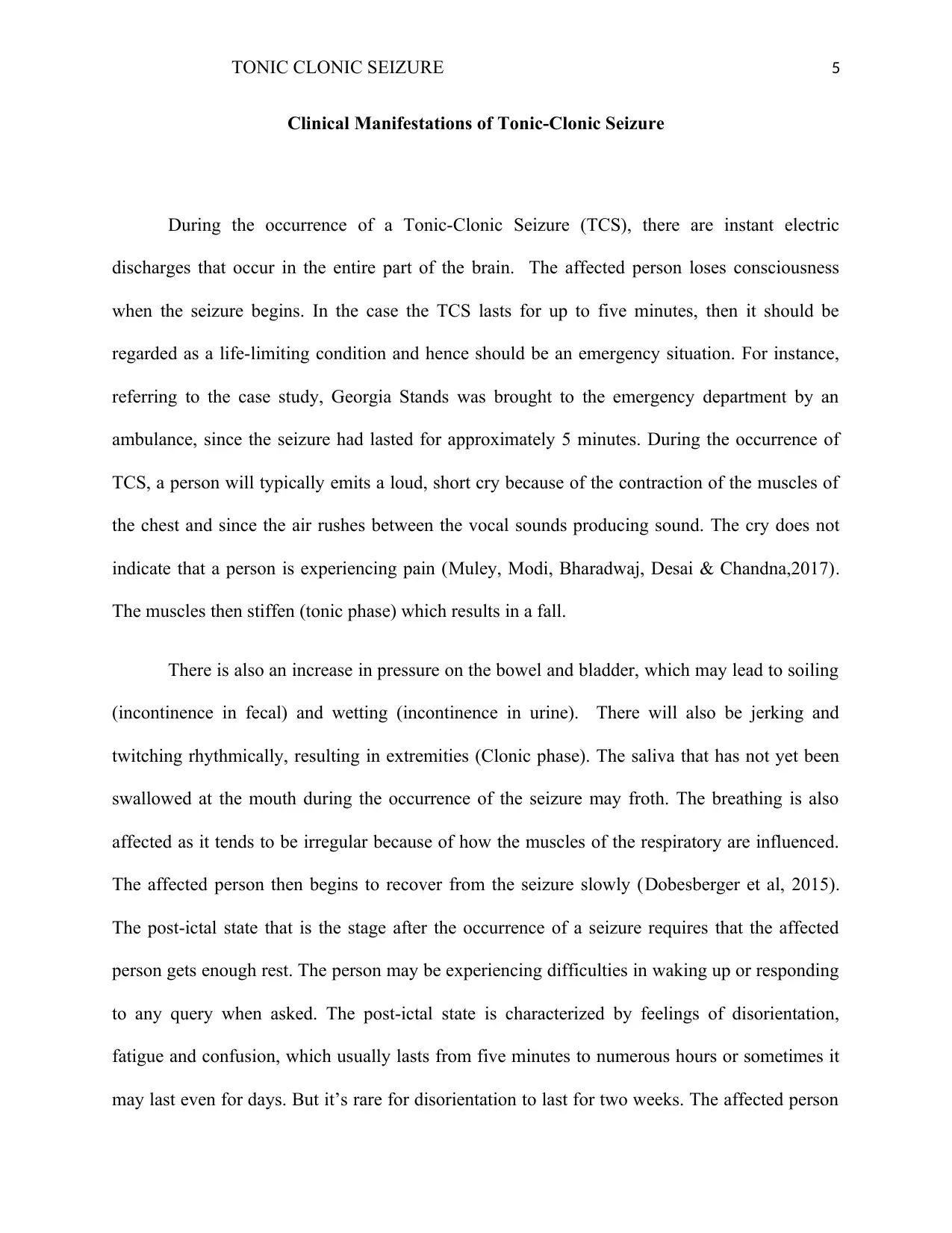
TONIC CLONIC SEIZURE 5
Clinical Manifestations of Tonic-Clonic Seizure
During the occurrence of a Tonic-Clonic Seizure (TCS), there are instant electric
discharges that occur in the entire part of the brain. The affected person loses consciousness
when the seizure begins. In the case the TCS lasts for up to five minutes, then it should be
regarded as a life-limiting condition and hence should be an emergency situation. For instance,
referring to the case study, Georgia Stands was brought to the emergency department by an
ambulance, since the seizure had lasted for approximately 5 minutes. During the occurrence of
TCS, a person will typically emits a loud, short cry because of the contraction of the muscles of
the chest and since the air rushes between the vocal sounds producing sound. The cry does not
indicate that a person is experiencing pain (Muley, Modi, Bharadwaj, Desai & Chandna,2017).
The muscles then stiffen (tonic phase) which results in a fall.
There is also an increase in pressure on the bowel and bladder, which may lead to soiling
(incontinence in fecal) and wetting (incontinence in urine). There will also be jerking and
twitching rhythmically, resulting in extremities (Clonic phase). The saliva that has not yet been
swallowed at the mouth during the occurrence of the seizure may froth. The breathing is also
affected as it tends to be irregular because of how the muscles of the respiratory are influenced.
The affected person then begins to recover from the seizure slowly (Dobesberger et al, 2015).
The post-ictal state that is the stage after the occurrence of a seizure requires that the affected
person gets enough rest. The person may be experiencing difficulties in waking up or responding
to any query when asked. The post-ictal state is characterized by feelings of disorientation,
fatigue and confusion, which usually lasts from five minutes to numerous hours or sometimes it
may last even for days. But it’s rare for disorientation to last for two weeks. The affected person
Clinical Manifestations of Tonic-Clonic Seizure
During the occurrence of a Tonic-Clonic Seizure (TCS), there are instant electric
discharges that occur in the entire part of the brain. The affected person loses consciousness
when the seizure begins. In the case the TCS lasts for up to five minutes, then it should be
regarded as a life-limiting condition and hence should be an emergency situation. For instance,
referring to the case study, Georgia Stands was brought to the emergency department by an
ambulance, since the seizure had lasted for approximately 5 minutes. During the occurrence of
TCS, a person will typically emits a loud, short cry because of the contraction of the muscles of
the chest and since the air rushes between the vocal sounds producing sound. The cry does not
indicate that a person is experiencing pain (Muley, Modi, Bharadwaj, Desai & Chandna,2017).
The muscles then stiffen (tonic phase) which results in a fall.
There is also an increase in pressure on the bowel and bladder, which may lead to soiling
(incontinence in fecal) and wetting (incontinence in urine). There will also be jerking and
twitching rhythmically, resulting in extremities (Clonic phase). The saliva that has not yet been
swallowed at the mouth during the occurrence of the seizure may froth. The breathing is also
affected as it tends to be irregular because of how the muscles of the respiratory are influenced.
The affected person then begins to recover from the seizure slowly (Dobesberger et al, 2015).
The post-ictal state that is the stage after the occurrence of a seizure requires that the affected
person gets enough rest. The person may be experiencing difficulties in waking up or responding
to any query when asked. The post-ictal state is characterized by feelings of disorientation,
fatigue and confusion, which usually lasts from five minutes to numerous hours or sometimes it
may last even for days. But it’s rare for disorientation to last for two weeks. The affected person
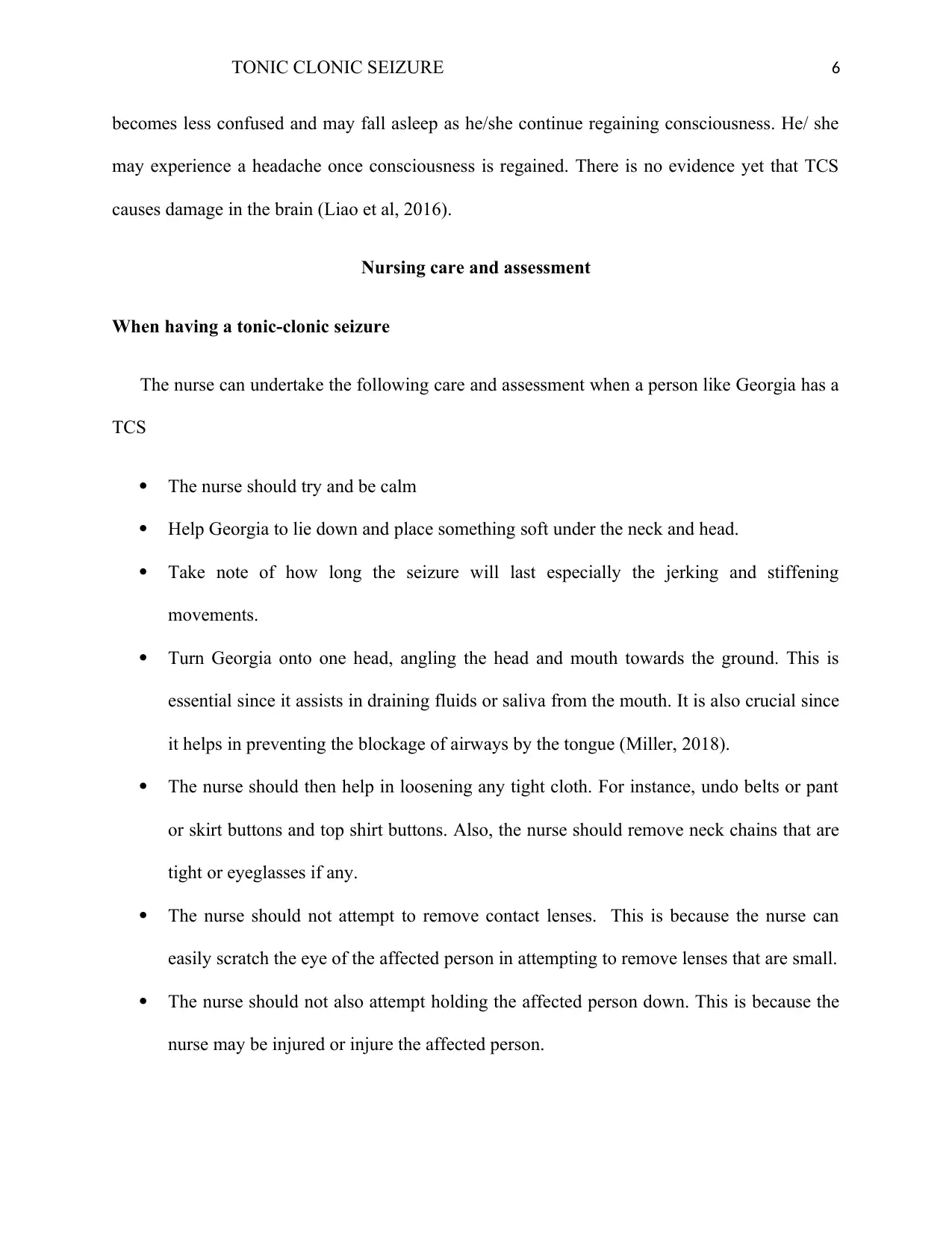
TONIC CLONIC SEIZURE 6
becomes less confused and may fall asleep as he/she continue regaining consciousness. He/ she
may experience a headache once consciousness is regained. There is no evidence yet that TCS
causes damage in the brain (Liao et al, 2016).
Nursing care and assessment
When having a tonic-clonic seizure
The nurse can undertake the following care and assessment when a person like Georgia has a
TCS
The nurse should try and be calm
Help Georgia to lie down and place something soft under the neck and head.
Take note of how long the seizure will last especially the jerking and stiffening
movements.
Turn Georgia onto one head, angling the head and mouth towards the ground. This is
essential since it assists in draining fluids or saliva from the mouth. It is also crucial since
it helps in preventing the blockage of airways by the tongue (Miller, 2018).
The nurse should then help in loosening any tight cloth. For instance, undo belts or pant
or skirt buttons and top shirt buttons. Also, the nurse should remove neck chains that are
tight or eyeglasses if any.
The nurse should not attempt to remove contact lenses. This is because the nurse can
easily scratch the eye of the affected person in attempting to remove lenses that are small.
The nurse should not also attempt holding the affected person down. This is because the
nurse may be injured or injure the affected person.
becomes less confused and may fall asleep as he/she continue regaining consciousness. He/ she
may experience a headache once consciousness is regained. There is no evidence yet that TCS
causes damage in the brain (Liao et al, 2016).
Nursing care and assessment
When having a tonic-clonic seizure
The nurse can undertake the following care and assessment when a person like Georgia has a
TCS
The nurse should try and be calm
Help Georgia to lie down and place something soft under the neck and head.
Take note of how long the seizure will last especially the jerking and stiffening
movements.
Turn Georgia onto one head, angling the head and mouth towards the ground. This is
essential since it assists in draining fluids or saliva from the mouth. It is also crucial since
it helps in preventing the blockage of airways by the tongue (Miller, 2018).
The nurse should then help in loosening any tight cloth. For instance, undo belts or pant
or skirt buttons and top shirt buttons. Also, the nurse should remove neck chains that are
tight or eyeglasses if any.
The nurse should not attempt to remove contact lenses. This is because the nurse can
easily scratch the eye of the affected person in attempting to remove lenses that are small.
The nurse should not also attempt holding the affected person down. This is because the
nurse may be injured or injure the affected person.
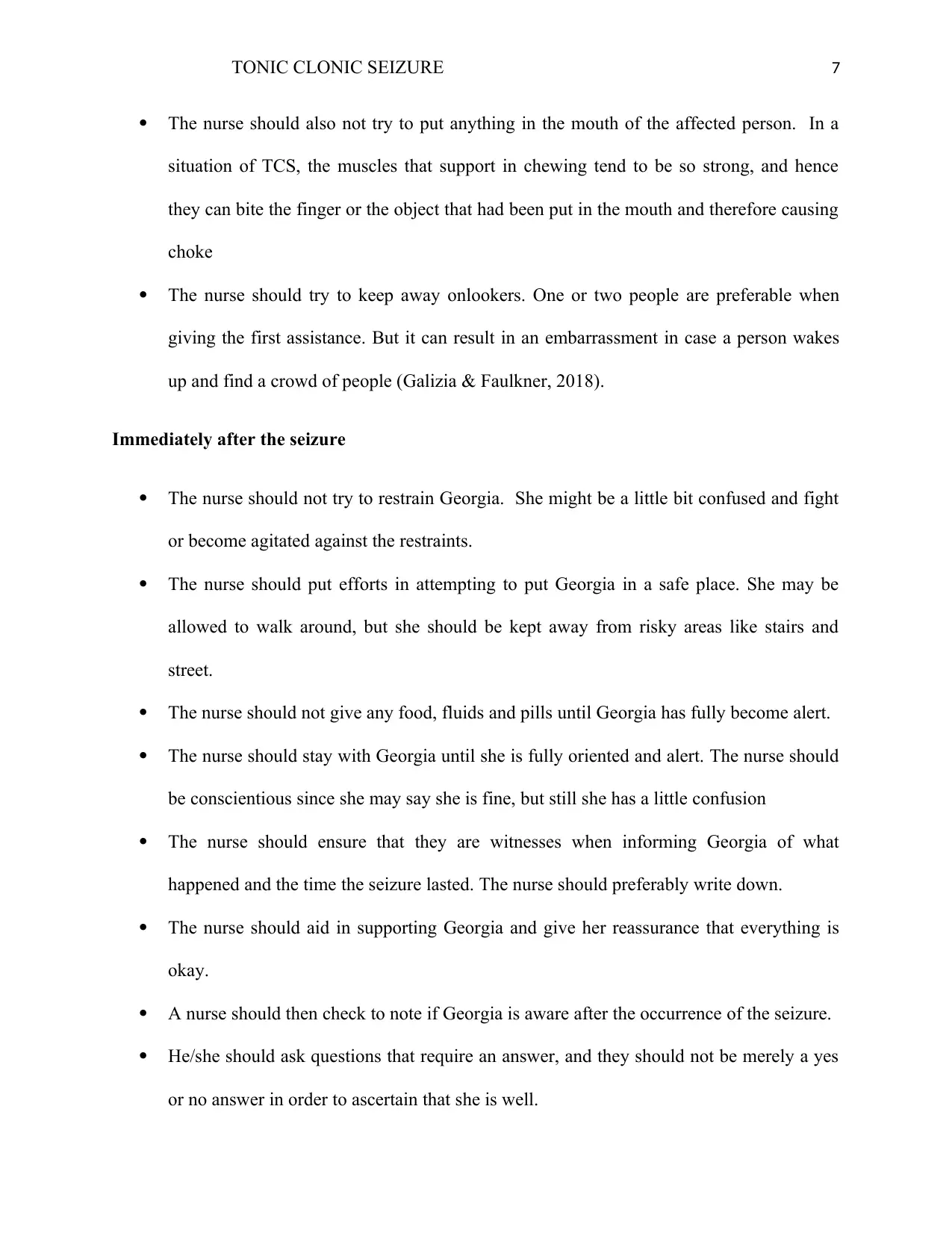
TONIC CLONIC SEIZURE 7
The nurse should also not try to put anything in the mouth of the affected person. In a
situation of TCS, the muscles that support in chewing tend to be so strong, and hence
they can bite the finger or the object that had been put in the mouth and therefore causing
choke
The nurse should try to keep away onlookers. One or two people are preferable when
giving the first assistance. But it can result in an embarrassment in case a person wakes
up and find a crowd of people (Galizia & Faulkner, 2018).
Immediately after the seizure
The nurse should not try to restrain Georgia. She might be a little bit confused and fight
or become agitated against the restraints.
The nurse should put efforts in attempting to put Georgia in a safe place. She may be
allowed to walk around, but she should be kept away from risky areas like stairs and
street.
The nurse should not give any food, fluids and pills until Georgia has fully become alert.
The nurse should stay with Georgia until she is fully oriented and alert. The nurse should
be conscientious since she may say she is fine, but still she has a little confusion
The nurse should ensure that they are witnesses when informing Georgia of what
happened and the time the seizure lasted. The nurse should preferably write down.
The nurse should aid in supporting Georgia and give her reassurance that everything is
okay.
A nurse should then check to note if Georgia is aware after the occurrence of the seizure.
He/she should ask questions that require an answer, and they should not be merely a yes
or no answer in order to ascertain that she is well.
The nurse should also not try to put anything in the mouth of the affected person. In a
situation of TCS, the muscles that support in chewing tend to be so strong, and hence
they can bite the finger or the object that had been put in the mouth and therefore causing
choke
The nurse should try to keep away onlookers. One or two people are preferable when
giving the first assistance. But it can result in an embarrassment in case a person wakes
up and find a crowd of people (Galizia & Faulkner, 2018).
Immediately after the seizure
The nurse should not try to restrain Georgia. She might be a little bit confused and fight
or become agitated against the restraints.
The nurse should put efforts in attempting to put Georgia in a safe place. She may be
allowed to walk around, but she should be kept away from risky areas like stairs and
street.
The nurse should not give any food, fluids and pills until Georgia has fully become alert.
The nurse should stay with Georgia until she is fully oriented and alert. The nurse should
be conscientious since she may say she is fine, but still she has a little confusion
The nurse should ensure that they are witnesses when informing Georgia of what
happened and the time the seizure lasted. The nurse should preferably write down.
The nurse should aid in supporting Georgia and give her reassurance that everything is
okay.
A nurse should then check to note if Georgia is aware after the occurrence of the seizure.
He/she should ask questions that require an answer, and they should not be merely a yes
or no answer in order to ascertain that she is well.
Paraphrase This Document
Need a fresh take? Get an instant paraphrase of this document with our AI Paraphraser
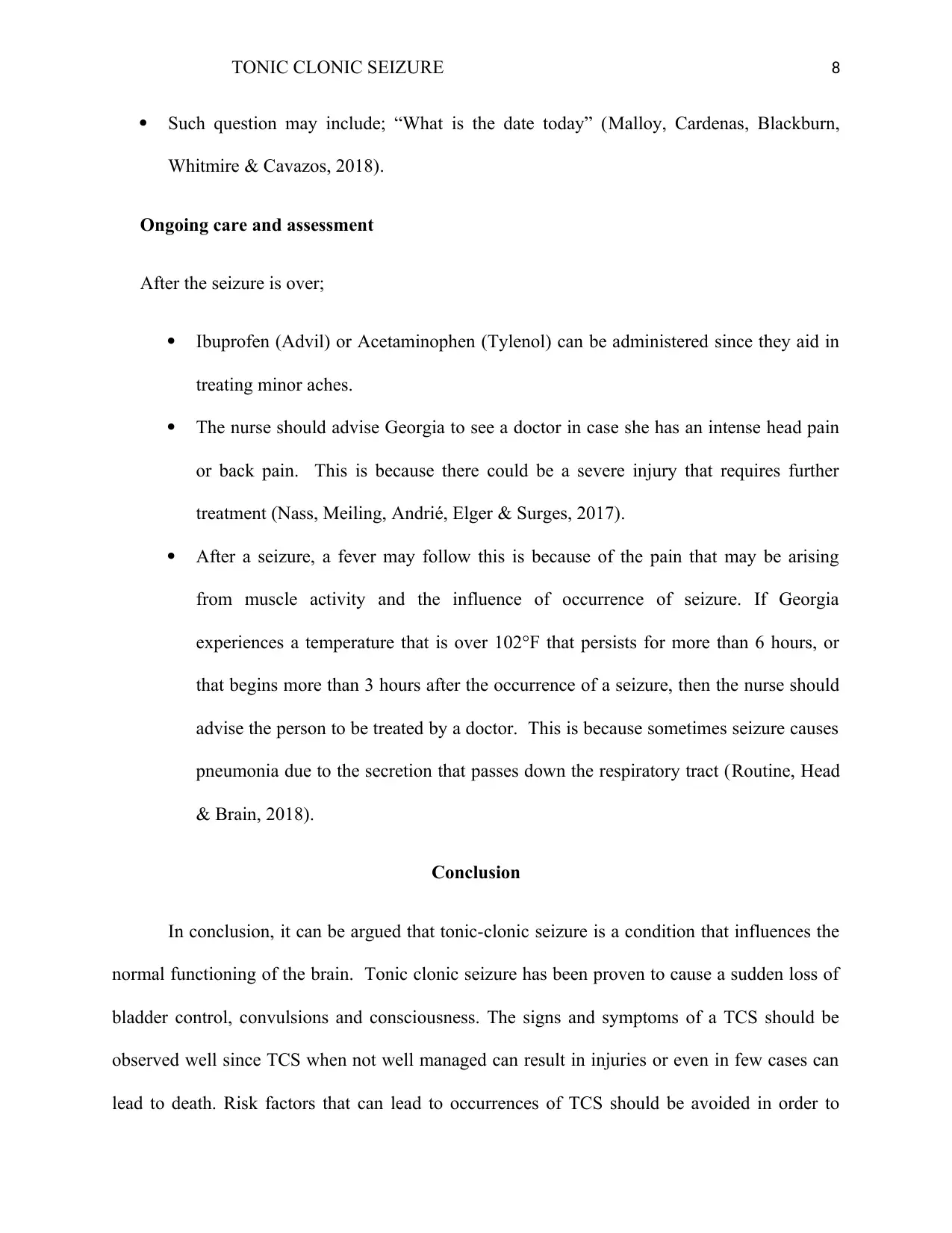
TONIC CLONIC SEIZURE 8
Such question may include; “What is the date today” (Malloy, Cardenas, Blackburn,
Whitmire & Cavazos, 2018).
Ongoing care and assessment
After the seizure is over;
Ibuprofen (Advil) or Acetaminophen (Tylenol) can be administered since they aid in
treating minor aches.
The nurse should advise Georgia to see a doctor in case she has an intense head pain
or back pain. This is because there could be a severe injury that requires further
treatment (Nass, Meiling, Andrié, Elger & Surges, 2017).
After a seizure, a fever may follow this is because of the pain that may be arising
from muscle activity and the influence of occurrence of seizure. If Georgia
experiences a temperature that is over 102°F that persists for more than 6 hours, or
that begins more than 3 hours after the occurrence of a seizure, then the nurse should
advise the person to be treated by a doctor. This is because sometimes seizure causes
pneumonia due to the secretion that passes down the respiratory tract (Routine, Head
& Brain, 2018).
Conclusion
In conclusion, it can be argued that tonic-clonic seizure is a condition that influences the
normal functioning of the brain. Tonic clonic seizure has been proven to cause a sudden loss of
bladder control, convulsions and consciousness. The signs and symptoms of a TCS should be
observed well since TCS when not well managed can result in injuries or even in few cases can
lead to death. Risk factors that can lead to occurrences of TCS should be avoided in order to
Such question may include; “What is the date today” (Malloy, Cardenas, Blackburn,
Whitmire & Cavazos, 2018).
Ongoing care and assessment
After the seizure is over;
Ibuprofen (Advil) or Acetaminophen (Tylenol) can be administered since they aid in
treating minor aches.
The nurse should advise Georgia to see a doctor in case she has an intense head pain
or back pain. This is because there could be a severe injury that requires further
treatment (Nass, Meiling, Andrié, Elger & Surges, 2017).
After a seizure, a fever may follow this is because of the pain that may be arising
from muscle activity and the influence of occurrence of seizure. If Georgia
experiences a temperature that is over 102°F that persists for more than 6 hours, or
that begins more than 3 hours after the occurrence of a seizure, then the nurse should
advise the person to be treated by a doctor. This is because sometimes seizure causes
pneumonia due to the secretion that passes down the respiratory tract (Routine, Head
& Brain, 2018).
Conclusion
In conclusion, it can be argued that tonic-clonic seizure is a condition that influences the
normal functioning of the brain. Tonic clonic seizure has been proven to cause a sudden loss of
bladder control, convulsions and consciousness. The signs and symptoms of a TCS should be
observed well since TCS when not well managed can result in injuries or even in few cases can
lead to death. Risk factors that can lead to occurrences of TCS should be avoided in order to
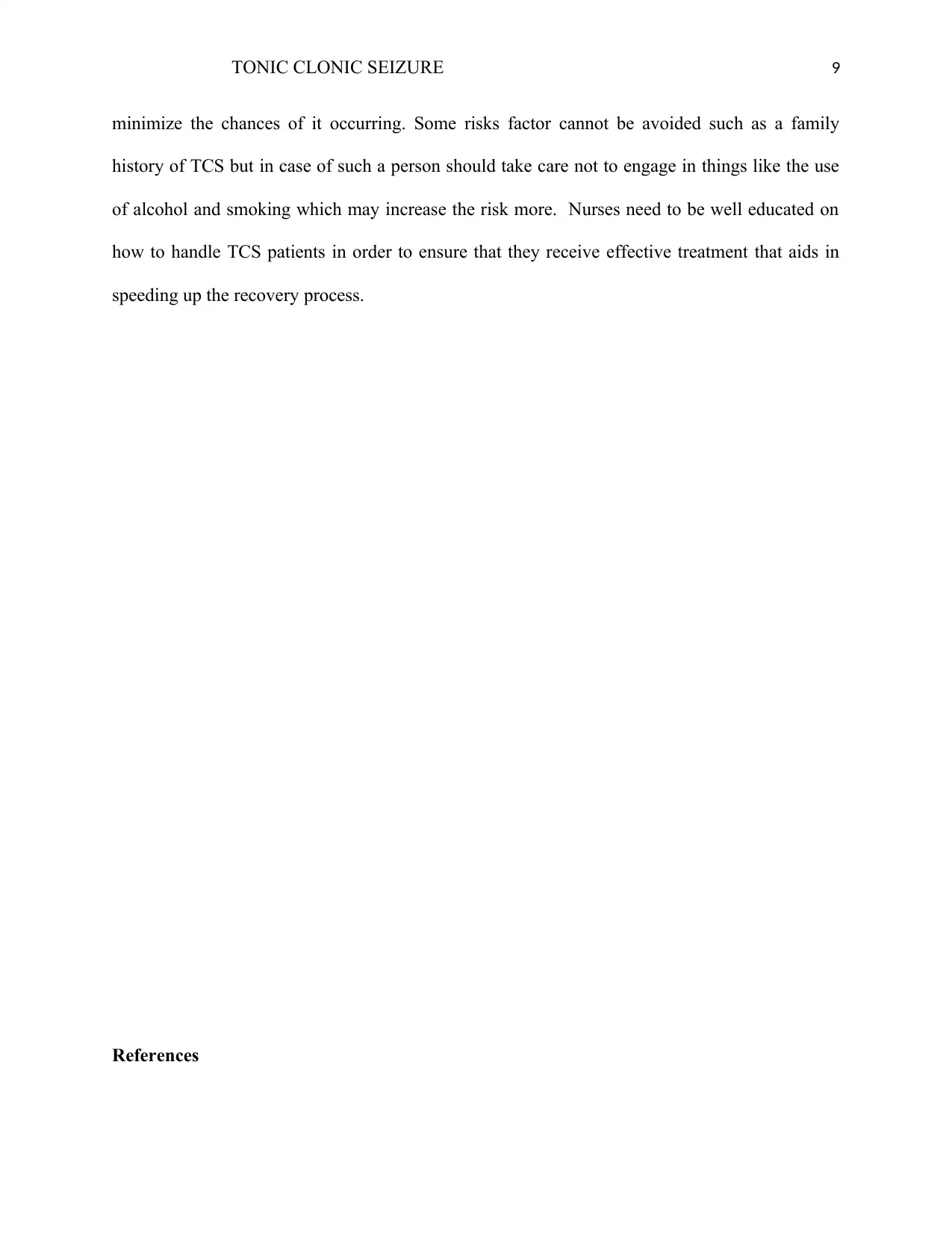
TONIC CLONIC SEIZURE 9
minimize the chances of it occurring. Some risks factor cannot be avoided such as a family
history of TCS but in case of such a person should take care not to engage in things like the use
of alcohol and smoking which may increase the risk more. Nurses need to be well educated on
how to handle TCS patients in order to ensure that they receive effective treatment that aids in
speeding up the recovery process.
References
minimize the chances of it occurring. Some risks factor cannot be avoided such as a family
history of TCS but in case of such a person should take care not to engage in things like the use
of alcohol and smoking which may increase the risk more. Nurses need to be well educated on
how to handle TCS patients in order to ensure that they receive effective treatment that aids in
speeding up the recovery process.
References
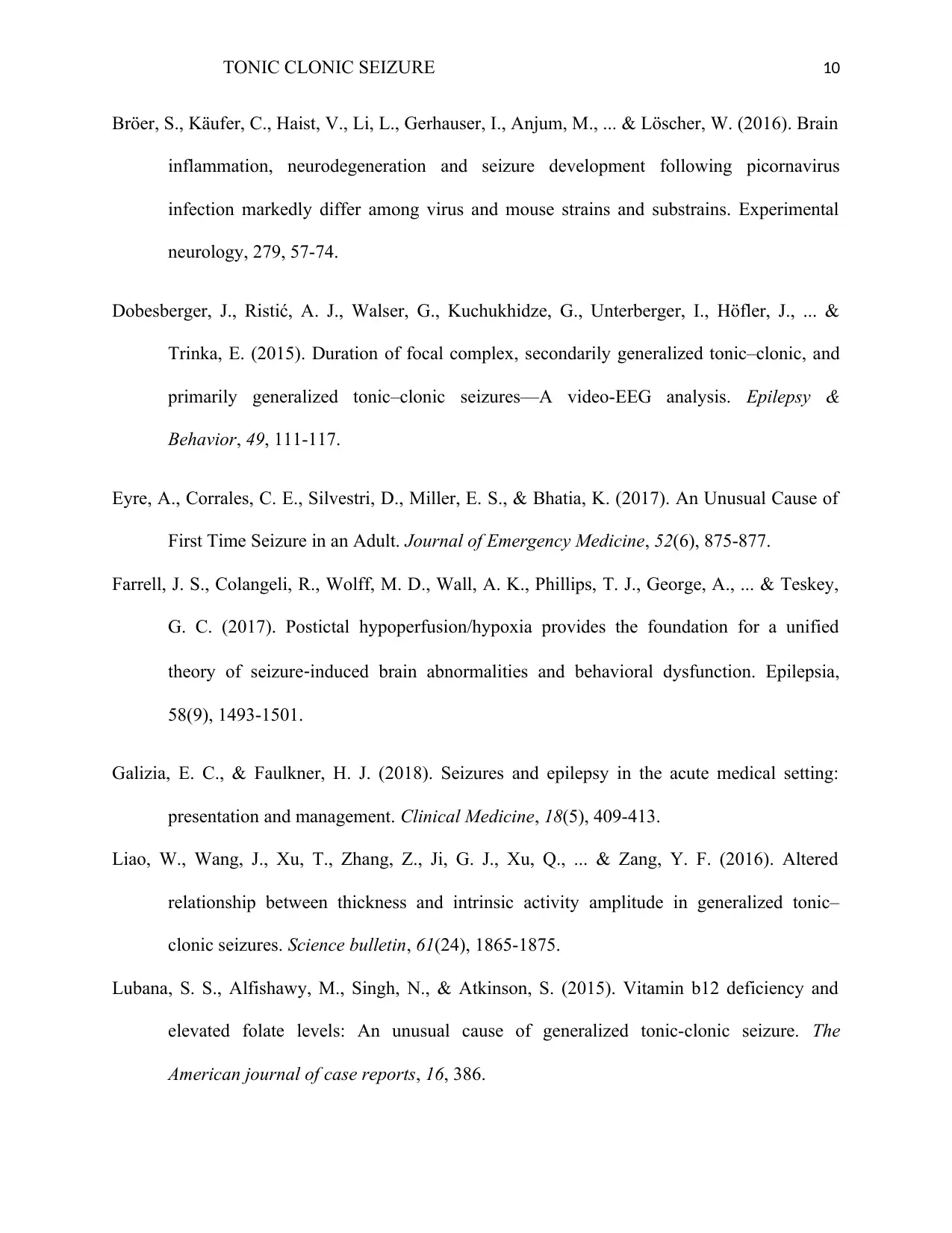
TONIC CLONIC SEIZURE 10
Bröer, S., Käufer, C., Haist, V., Li, L., Gerhauser, I., Anjum, M., ... & Löscher, W. (2016). Brain
inflammation, neurodegeneration and seizure development following picornavirus
infection markedly differ among virus and mouse strains and substrains. Experimental
neurology, 279, 57-74.
Dobesberger, J., Ristić, A. J., Walser, G., Kuchukhidze, G., Unterberger, I., Höfler, J., ... &
Trinka, E. (2015). Duration of focal complex, secondarily generalized tonic–clonic, and
primarily generalized tonic–clonic seizures—A video-EEG analysis. Epilepsy &
Behavior, 49, 111-117.
Eyre, A., Corrales, C. E., Silvestri, D., Miller, E. S., & Bhatia, K. (2017). An Unusual Cause of
First Time Seizure in an Adult. Journal of Emergency Medicine, 52(6), 875-877.
Farrell, J. S., Colangeli, R., Wolff, M. D., Wall, A. K., Phillips, T. J., George, A., ... & Teskey,
G. C. (2017). Postictal hypoperfusion/hypoxia provides the foundation for a unified
theory of seizure‐induced brain abnormalities and behavioral dysfunction. Epilepsia,
58(9), 1493-1501.
Galizia, E. C., & Faulkner, H. J. (2018). Seizures and epilepsy in the acute medical setting:
presentation and management. Clinical Medicine, 18(5), 409-413.
Liao, W., Wang, J., Xu, T., Zhang, Z., Ji, G. J., Xu, Q., ... & Zang, Y. F. (2016). Altered
relationship between thickness and intrinsic activity amplitude in generalized tonic–
clonic seizures. Science bulletin, 61(24), 1865-1875.
Lubana, S. S., Alfishawy, M., Singh, N., & Atkinson, S. (2015). Vitamin b12 deficiency and
elevated folate levels: An unusual cause of generalized tonic-clonic seizure. The
American journal of case reports, 16, 386.
Bröer, S., Käufer, C., Haist, V., Li, L., Gerhauser, I., Anjum, M., ... & Löscher, W. (2016). Brain
inflammation, neurodegeneration and seizure development following picornavirus
infection markedly differ among virus and mouse strains and substrains. Experimental
neurology, 279, 57-74.
Dobesberger, J., Ristić, A. J., Walser, G., Kuchukhidze, G., Unterberger, I., Höfler, J., ... &
Trinka, E. (2015). Duration of focal complex, secondarily generalized tonic–clonic, and
primarily generalized tonic–clonic seizures—A video-EEG analysis. Epilepsy &
Behavior, 49, 111-117.
Eyre, A., Corrales, C. E., Silvestri, D., Miller, E. S., & Bhatia, K. (2017). An Unusual Cause of
First Time Seizure in an Adult. Journal of Emergency Medicine, 52(6), 875-877.
Farrell, J. S., Colangeli, R., Wolff, M. D., Wall, A. K., Phillips, T. J., George, A., ... & Teskey,
G. C. (2017). Postictal hypoperfusion/hypoxia provides the foundation for a unified
theory of seizure‐induced brain abnormalities and behavioral dysfunction. Epilepsia,
58(9), 1493-1501.
Galizia, E. C., & Faulkner, H. J. (2018). Seizures and epilepsy in the acute medical setting:
presentation and management. Clinical Medicine, 18(5), 409-413.
Liao, W., Wang, J., Xu, T., Zhang, Z., Ji, G. J., Xu, Q., ... & Zang, Y. F. (2016). Altered
relationship between thickness and intrinsic activity amplitude in generalized tonic–
clonic seizures. Science bulletin, 61(24), 1865-1875.
Lubana, S. S., Alfishawy, M., Singh, N., & Atkinson, S. (2015). Vitamin b12 deficiency and
elevated folate levels: An unusual cause of generalized tonic-clonic seizure. The
American journal of case reports, 16, 386.
Secure Best Marks with AI Grader
Need help grading? Try our AI Grader for instant feedback on your assignments.
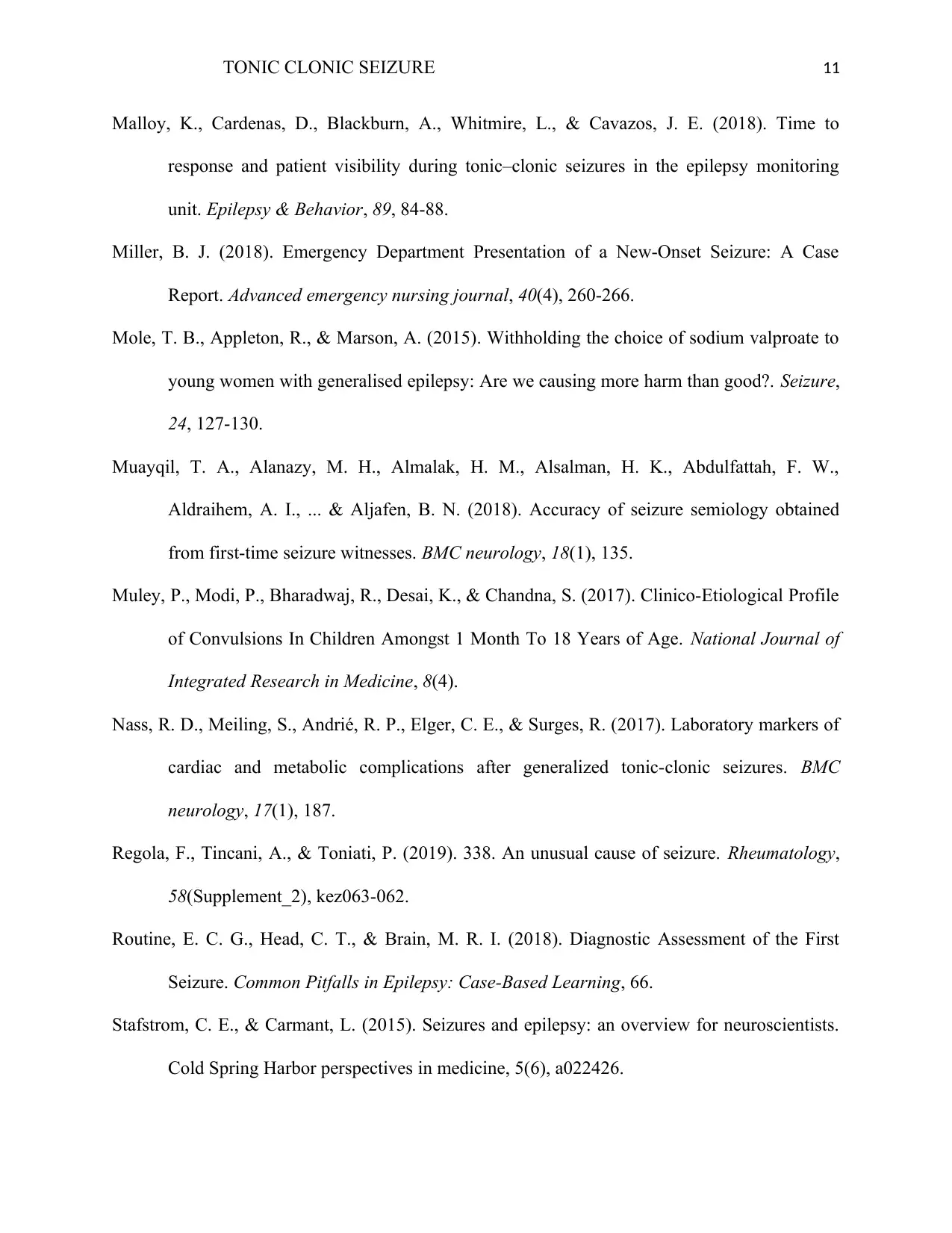
TONIC CLONIC SEIZURE 11
Malloy, K., Cardenas, D., Blackburn, A., Whitmire, L., & Cavazos, J. E. (2018). Time to
response and patient visibility during tonic–clonic seizures in the epilepsy monitoring
unit. Epilepsy & Behavior, 89, 84-88.
Miller, B. J. (2018). Emergency Department Presentation of a New-Onset Seizure: A Case
Report. Advanced emergency nursing journal, 40(4), 260-266.
Mole, T. B., Appleton, R., & Marson, A. (2015). Withholding the choice of sodium valproate to
young women with generalised epilepsy: Are we causing more harm than good?. Seizure,
24, 127-130.
Muayqil, T. A., Alanazy, M. H., Almalak, H. M., Alsalman, H. K., Abdulfattah, F. W.,
Aldraihem, A. I., ... & Aljafen, B. N. (2018). Accuracy of seizure semiology obtained
from first-time seizure witnesses. BMC neurology, 18(1), 135.
Muley, P., Modi, P., Bharadwaj, R., Desai, K., & Chandna, S. (2017). Clinico-Etiological Profile
of Convulsions In Children Amongst 1 Month To 18 Years of Age. National Journal of
Integrated Research in Medicine, 8(4).
Nass, R. D., Meiling, S., Andrié, R. P., Elger, C. E., & Surges, R. (2017). Laboratory markers of
cardiac and metabolic complications after generalized tonic-clonic seizures. BMC
neurology, 17(1), 187.
Regola, F., Tincani, A., & Toniati, P. (2019). 338. An unusual cause of seizure. Rheumatology,
58(Supplement_2), kez063-062.
Routine, E. C. G., Head, C. T., & Brain, M. R. I. (2018). Diagnostic Assessment of the First
Seizure. Common Pitfalls in Epilepsy: Case-Based Learning, 66.
Stafstrom, C. E., & Carmant, L. (2015). Seizures and epilepsy: an overview for neuroscientists.
Cold Spring Harbor perspectives in medicine, 5(6), a022426.
Malloy, K., Cardenas, D., Blackburn, A., Whitmire, L., & Cavazos, J. E. (2018). Time to
response and patient visibility during tonic–clonic seizures in the epilepsy monitoring
unit. Epilepsy & Behavior, 89, 84-88.
Miller, B. J. (2018). Emergency Department Presentation of a New-Onset Seizure: A Case
Report. Advanced emergency nursing journal, 40(4), 260-266.
Mole, T. B., Appleton, R., & Marson, A. (2015). Withholding the choice of sodium valproate to
young women with generalised epilepsy: Are we causing more harm than good?. Seizure,
24, 127-130.
Muayqil, T. A., Alanazy, M. H., Almalak, H. M., Alsalman, H. K., Abdulfattah, F. W.,
Aldraihem, A. I., ... & Aljafen, B. N. (2018). Accuracy of seizure semiology obtained
from first-time seizure witnesses. BMC neurology, 18(1), 135.
Muley, P., Modi, P., Bharadwaj, R., Desai, K., & Chandna, S. (2017). Clinico-Etiological Profile
of Convulsions In Children Amongst 1 Month To 18 Years of Age. National Journal of
Integrated Research in Medicine, 8(4).
Nass, R. D., Meiling, S., Andrié, R. P., Elger, C. E., & Surges, R. (2017). Laboratory markers of
cardiac and metabolic complications after generalized tonic-clonic seizures. BMC
neurology, 17(1), 187.
Regola, F., Tincani, A., & Toniati, P. (2019). 338. An unusual cause of seizure. Rheumatology,
58(Supplement_2), kez063-062.
Routine, E. C. G., Head, C. T., & Brain, M. R. I. (2018). Diagnostic Assessment of the First
Seizure. Common Pitfalls in Epilepsy: Case-Based Learning, 66.
Stafstrom, C. E., & Carmant, L. (2015). Seizures and epilepsy: an overview for neuroscientists.
Cold Spring Harbor perspectives in medicine, 5(6), a022426.

TONIC CLONIC SEIZURE 12
1 out of 12
Your All-in-One AI-Powered Toolkit for Academic Success.
+13062052269
info@desklib.com
Available 24*7 on WhatsApp / Email
![[object Object]](/_next/static/media/star-bottom.7253800d.svg)
Unlock your academic potential
© 2024 | Zucol Services PVT LTD | All rights reserved.

